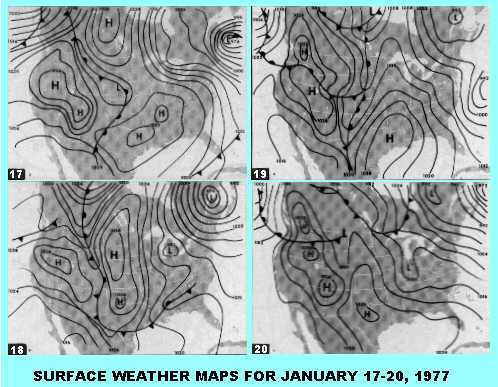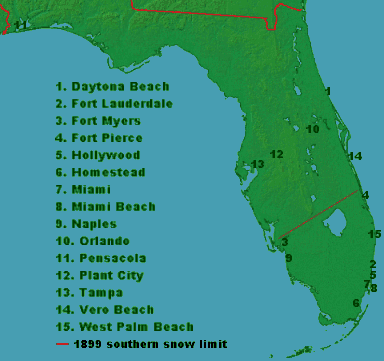 |
 |
| Home | Welcome | What's New | Site Map | Glossary | Weather Doctor Amazon Store | Book Store | Accolades | Email Us |
 | |||||||||
Weather Almanac for January 2002MIAMI'S FIRST SNOWFALLOn January 19, 1977, Old Man Winter paid an unwelcomed visit to residents of Miami, Florida (yes, Florida, not Ohio) and brought along a surprise gift -- snow! For the first time in the history of the extreme south of Florida, snow danced through the air and dusted the ground briefly. A quarter century later, the scene has not been repeated. The event was but one in a series of frigid weather headlines in the United States during 1977, and in many cities, it drove news of President Jimmy Carter's inauguration from the top story of the day. The Winter of 1976-77 will long be remembered by residents in the eastern half of the United States and the southeastern half of Canada. The winter ranked as the coldest to date in the US east of about the Mississippi River, averaging 4-6 Fo below normal (2.2-3.3 Co below). In a winter where abnormal was normal, January 1977 was the showcase month in many areas. In the US from New Hampshire to Minnesota and south to Louisiana and Florida, 64 cities registered their coldest or second coldest January on record. For twenty four metropoli, it was also the coldest month ever experienced. The cause of the unrelenting cold was a persistent atmospheric circulation pattern that established itself in early autumn 1976 and remained remarkably unchanged until late February 1977. The Aleutian Low, a semi-permanent feature of the annual circulation map, was especially deep and large that winter, spreading to cover most of the North Pacific by January. It maintained a stronger-than-normal upper-level ridge over western North America and a deeper-than-normal upper-level trough over eastern regions of the continent. A large blocking high pressure cell pushed the polar vortex far south into southern Canada, and this extremely cold air streamed out from the arctic across the eastern and central United States and southeastern Canada.  The cold air rushing across the Great Lakes buried the basin's snowbelt areas from November to January with conditions particularly severe in upper New York State. Buffalo, New York received so much snow -- a total of 181.1 inches (460 cm) between October 1 and March 1 -- that the city was forced to ship snow removed from streets out of town by rail. The full story of this extraordinary Winter deserves a book-length treatment, which is not our intention here. The story on which we focus here took place 1400 miles (2250 km) to the south, in a state know mostly as a refuge from winter. The morning of January 19, 1977 was a great surprise to the residents of Greater Miami who thought themselves exempt from the ravages of winter raging to the north. The Miami Herald confirmed the event in banner headlines of a size usually reserved for the declaration of war or of victory. The front page of the January 20 edition read: Snow Falls on S. FloridaBitter Cold, High Wind Turn KillerThe event also made national and international media headlines as well. And why not?!? It had never snowed, according to the historical record, this far south in Florida. In the record cold Winter of 1899, snow had been reported as far south as a line from Fort Myers on the state's west coast to Fort Pierce on the east coast, but never had it crossed the Everglades into the Miami region. The surface weather situation over eastern North America set up a flow of arctic air directly to Florida. A strong, cold high pressure ridge, which had become a nearly stationary feature of January's weather map, had sat over the Mississippi Valley for nearly a week, its centre slipping into east Texas/west Louisiana on the 18th. Along the Atlantic Coast, a deep Nor'easter cyclone, born off Hatteras on the 15th, swirled northward to be over the Gulf of St. Lawrence on the 18th. Pushed by the great pressure gradient between the ridge and the cyclone, bitterly cold air from the Hudson Bay lowlands channelled southward to the Gulf States and into the Caribbean. The residents of northern Florida around Pensacola were the first to see snow fall on the Sunshine State, receiving 1-2 inches (2.5-5.0 cm) on January 18. Frigid, gusty northwest winds of 40-45 mph (64-72 km/h) pushed the line of falling snow southward, so that by the end of the day, every weather station in north and central Florida had echoed the word: Snow. Tampa recorded its greatest accumulation to date: 0.2 inches (0.5 cm). Plant City measured nearly two inches (five cm) on the ground, and Orlando, Daytona Beach and Vero Beach confirmed falling snow or snow on the ground.  Overnight, the cold and snow continued marching ever southward. On Wednesday, January 19 at 6:10 AM, West Palm Beach reported snow falling for the first time on record. An hour later, the Miami area weather forecast was amended to include the likelihood of snow mixed with rain. This was the first forecast for snow ever issued for the city. For most of Greater Miami, the forecast was on the mark. From 8:30 to 9:00 AM, snow reports emanated from the Fort Lauderdale/Hollywood International Airport in Broward County. Homestead, 23 miles (37 km) southwest of Miami in southern Dade County (latitude 25 deg, 30 minutes), reported snow falling. While observers at Miami International Airport never officially reported snow, radar picked up echos of snow falling around the city, and there were numerous public sightings of the unusual precipitation, including some from Miami Beach. The fine granular snow crystals dusted the palms and baptised the ground with white water, but they soon melted. Most children, and many adults, had never seen snow before -- at least not live and in concert. "They were ecstatic, running around with their tongues out, trying to catch the snow in their mouths," commented Wilton Manors Elementary School principal, Mary Crum. The snow and cold continued to move southeastward, bringing snow mixed with cold rain to Freeport in the Bahamas. Within a couple of days, weather conditions returned to near normal in south Florida. The snow was the prime topic for conversation on the 19th and 20th, but the accompanying cold was devastating to Florida's economy. Damage to crops in Dade County alone reached the $100 million (1977 dollars) mark. The entire mainland of Florida fell below freezing and record low temperatures were registered at many locations. Naples fell to 26 oF (-3.3 oC); West Palm Beach recorded a low of 27 oF (-2.8 oC); Miami Beach sat on the freezing mark 32 oF (0 oC) and only rose to a chilling 47 oF (8.3 oC) that afternoon, the coldest maximum on record. Sections of Dade and Broward Counties plummeted to record minimum temperatures as low as 20 oF (-6.6 oC), and remained below freezing for 10-14 hours. The depth and duration of the cold were beyond the capabilities of most frost-protection systems, and thus the citrus and vegetable growers suffered heavy losses. Temple oranges, tangelos and tangerines were almost totally destroyed. The same fate fell on tender vegetables such as beans, tomatoes, corn and squash at a time when they were in most demand. As a consequence of the crop damage, thousands of migrant farm labourers became unemployed at what should have been their busiest time. Ice on Florida highways caused hundreds of accidents, for drivers were not accustomed to driving on slick roads. Portions of Florida's Interstate Highway system were forced to close due to the poor traction on the freezing surfaces. High winds over the offshore waters damaged several boats: sinking a Panamanian freighter carrying sugar from the Dominican to Galveston and pushed a four-masted schooner with 137 aboard aground off Eleuthera Island in the Bahamas. When the white dust had cleared, President Carter declared 35 Florida counties disaster areas. The Pensacola region would again see snow fall later in January 1977, but the extreme cold did not penetrate as far south this time. Florida as a state would experience extreme cold spells in 1983 and 1985 with Miami reported a sub-freezing low on the night of January 22, 1985, but snow has not been seen this far south since that historic day in 1977. Learn More From This Relevant Book
|
|||||||||
 |
To Purchase Notecard, |
Now Available! Order Today! | |
 |
 |
NEW! Now |
The BC Weather Book: |


